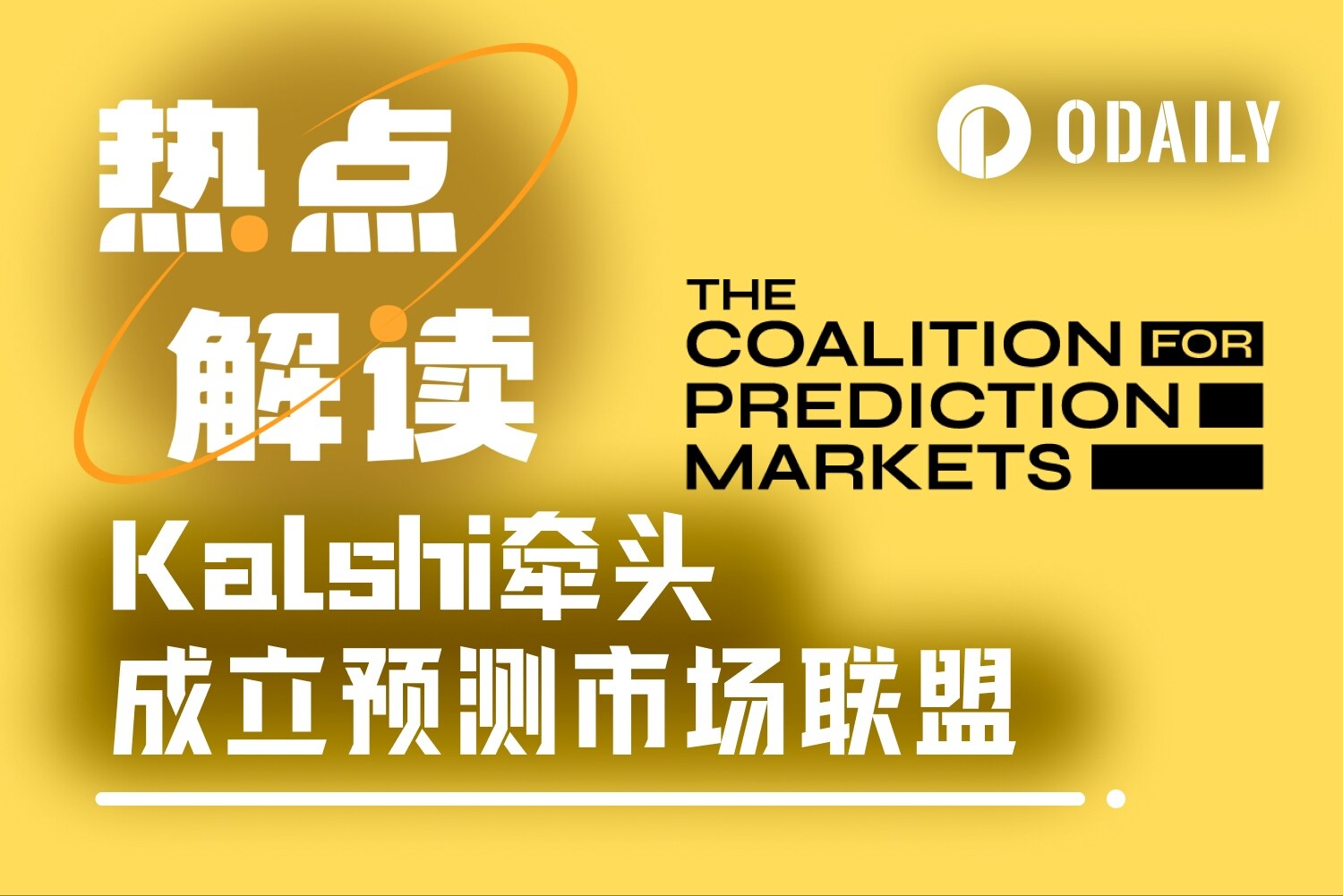Making money while simultaneously squandering it: a look at the recent activities of these leading Perp DEXs.
- 核心观点:Perp DEX市场由五大平台主导。
- 关键要素:
- Aster交易量121.2亿美元居首。
- Lighter融资传闻达15亿美元。
- 五大平台总交易量超338亿美元。
- 市场影响:引导资金流向头部平台。
- 时效性标注:短期影响。
According to the latest on-chain data, the market landscape of decentralized perpetual contract exchanges (Perp DEX) has become relatively clear. In terms of 24-hour trading volume, Aster tops the list with $12.12 billion, Lighter is second with $8.616 billion, Hyperliquid is third with $5.958 billion, and edgeX and ApeX Protocol occupy fourth and fifth place with $5.06 billion and $2.122 billion respectively.
The combined trading volume of these five platforms exceeds $33.8 billion, giving them an absolute dominant position in the entire Perp DEX sector.
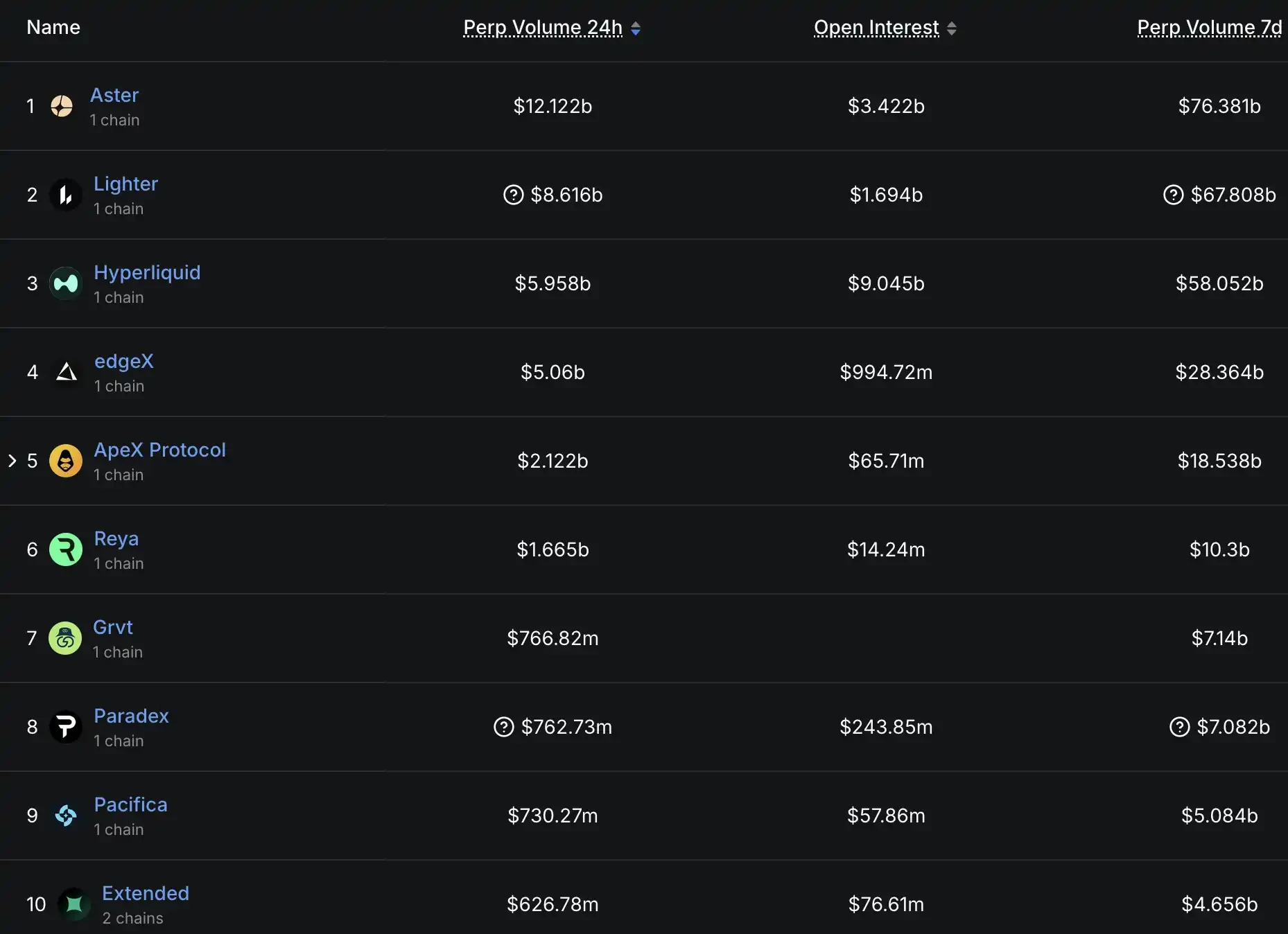
For investors and traders who want to gain a deeper understanding of the Perp DEX sector, keeping track of the dynamics of these five platforms is essential to grasping the overall trend of the sector. Therefore, this article by BlockBeats provides a detailed overview of the recent important developments, product updates, and community activities of these five platforms, helping readers to fully understand the latest developments in the current decentralized derivatives trading market.
Lighter
1. A source, presumably an insider, revealed that Lighter has raised $1.5 billion.
Recently, an insider who accurately predicted Coinbase's acquisition of Echo and Kalshi's $12 billion valuation hinted, in the same riddle-like form, that Lighter's funding round reached $1.5 billion. This news has generated widespread attention in the community, and although there has been no official confirmation, the insider's previous accurate predictions have amplified the rumor's reach.
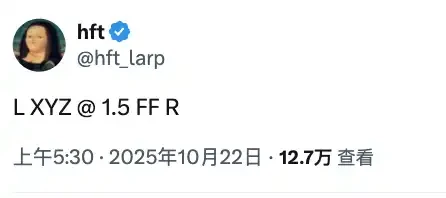
Market performance data from Polymarket shows strong investor optimism for Lighter: 88% predict its first-day FDV will exceed $2 billion, and 55% predict it will exceed $4 billion. Meanwhile, the OTC market price has remained stable at around $80.
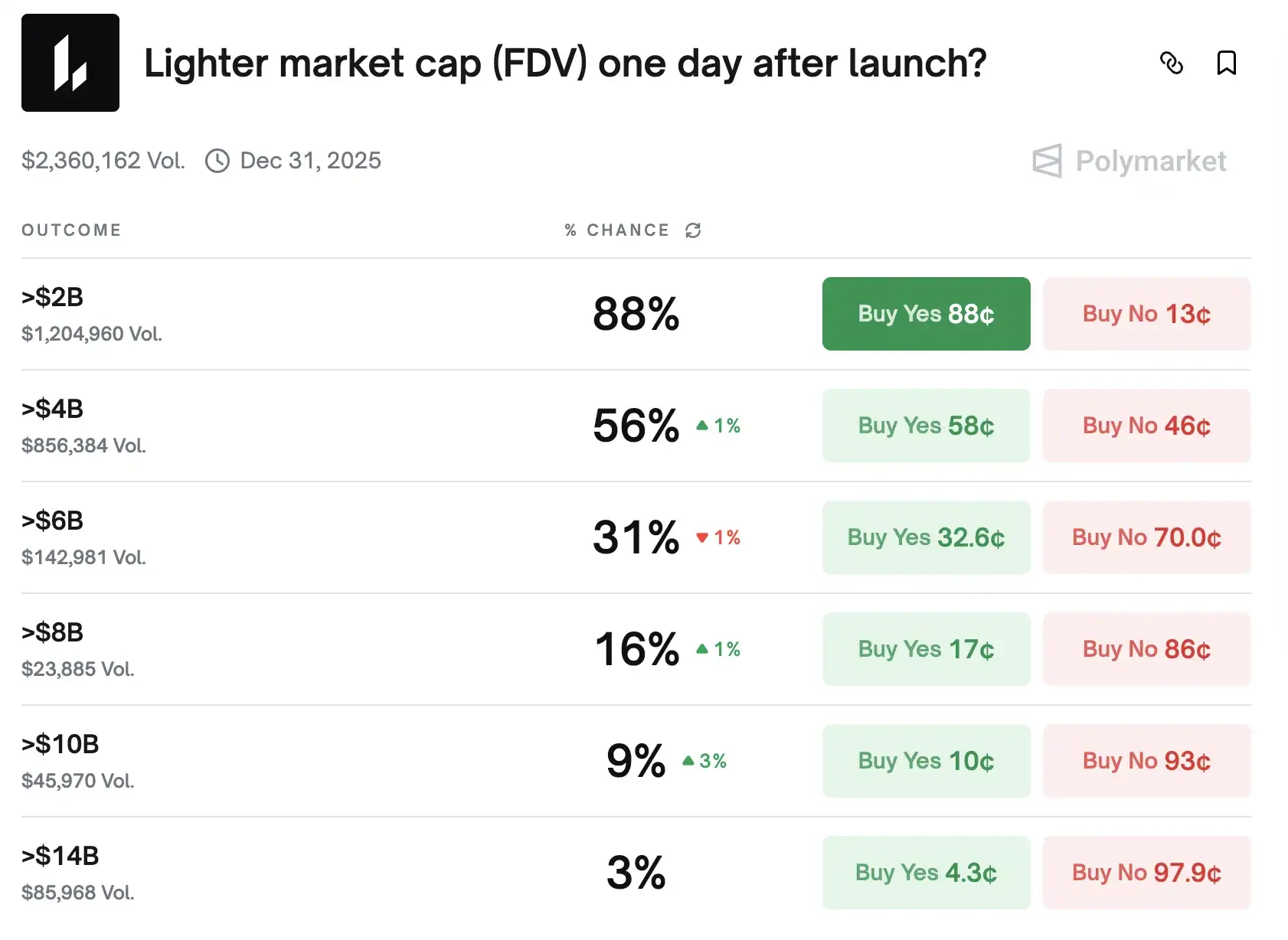
2. Lighter CEO hints that Lighter airdrops will occur during major holidays.
Lighter CEO's latest hint on Twitter has given the community a clearer expectation of the airdrop timing. He clarified that the second quarter points program will end before the end of the year, but not on December 31, and tweeted, "The holidays will be lit this year."
Based on this information, the community generally speculates that the airdrop is most likely to take place during Christmas, the most important holiday in the West.
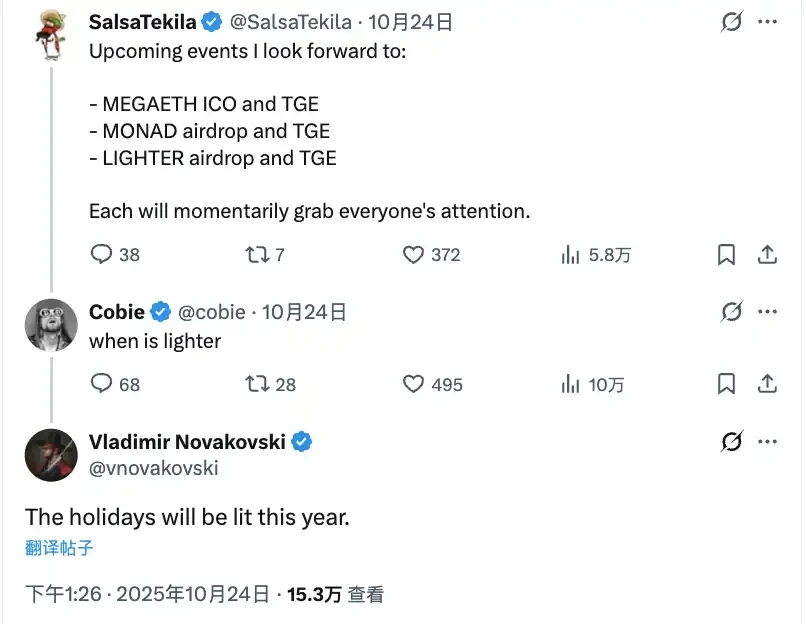
Data from Polymarket further confirms this expectation, showing a 90% probability that Lighter will complete its airdrop by December 31st. This means participants could receive their long-awaited token rewards before the end of the year.
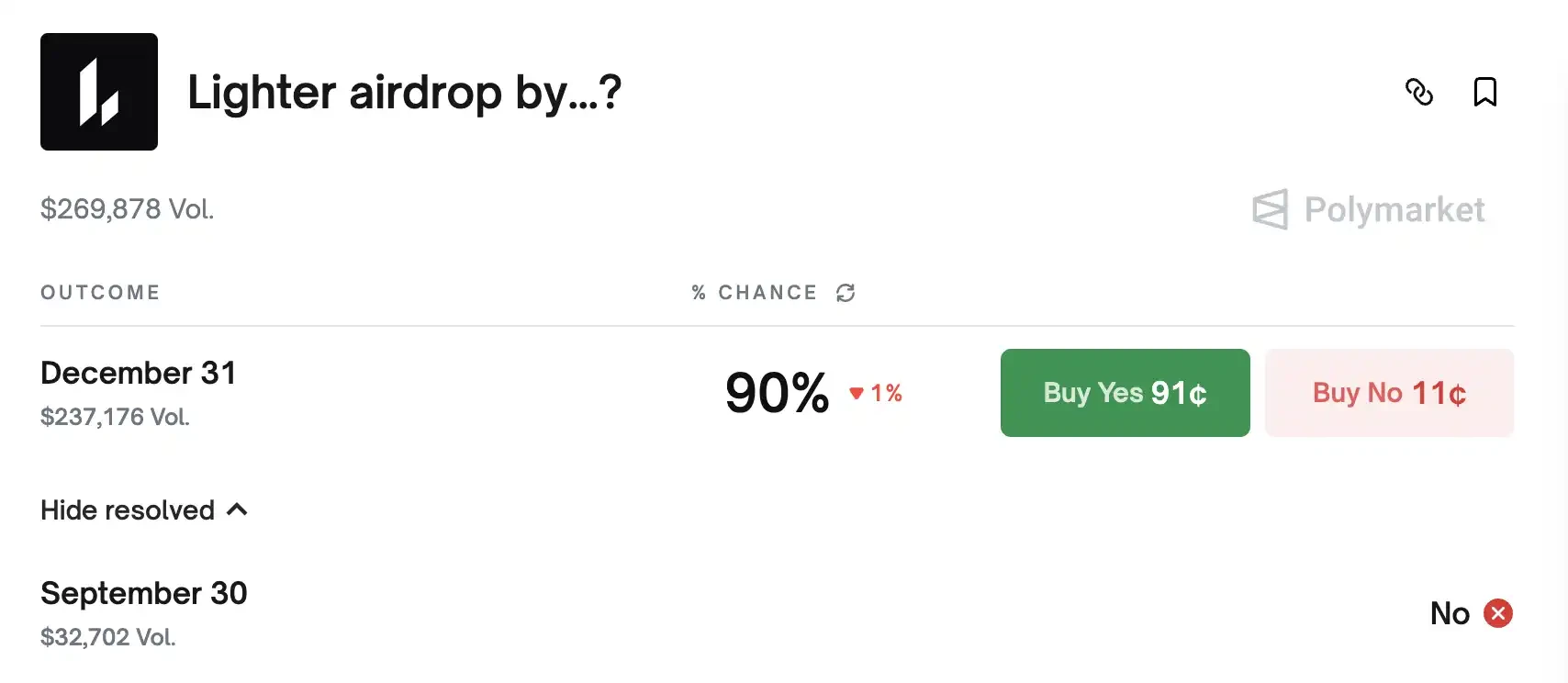
3. Lighter Season 2 Rule Adjustments
Lighter announced some adjustments to its Season 2 points distribution rules this month compared to Season 1. 200,000 points will be distributed every Friday, covering trading activities from Wednesday to the following Tuesday. The distribution mechanism is more diversified, comprehensively considering multiple dimensions such as trading volume, open interest, vault capacity, liquidation and leverage ratios, profit and loss, and trading categories.
It's important to note that the relationship between points and trading metrics is not a simple linear one. For example, twice the trading volume may generate three times or 1.5 times the points; this non-linear design aims to encourage more diverse trading behavior. The platform employs a hybrid fully and semi-automatic Sybil detection system, allowing each user a maximum of 10 accounts without penalty; exceeding this limit will result in penalties.
For details, please refer to the official documentation .
4. Token Economics and Product Roadmap
Two weeks ago, the founder of Lighter held a Russian AMA, revealing some key information:
Lighter plans to allocate 25-30% of its tokens to the Q1 and Q2 airdrops, with the community receiving 50% of the total allocation. The remaining portion will be used for future airdrops, partner programs, and funded projects.
In terms of products, the spot trading function is expected to be launched at the end of October or the beginning of November. The first batch of assets to be launched will be core assets such as ETH and BTC, followed by the addition of selected meme coins and partner projects.
The roadmap for the next 6-12 months: Implement cross-margin functionality by the end of the year, allowing the use of spot as collateral for perpetual contracts; launch the EVM "sidecar" smart contract extension early next year; RWA derivatives (precious metals and crypto-related stocks) are planned to launch by the end of the year; options and dark pool functionality are scheduled to launch next year and the end of next year, respectively.
5. Arbitrage opportunities
Community user Your Quant Guy shared an arbitrage alpha strategy for Lighter with an annualized return of approximately 51.5%.
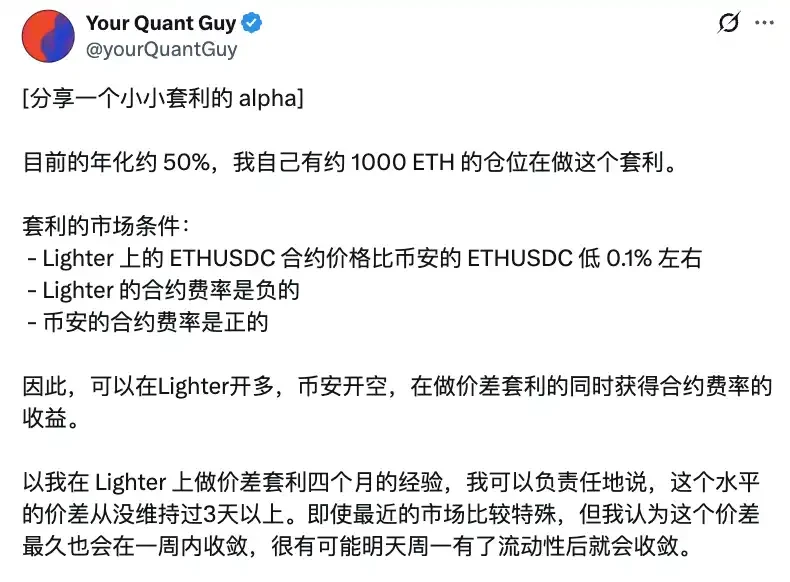
6. Data Performance
According to dashboards created by the community and data from Lighterlytics , Lighter's current TVL is 1.15B, with a growth rate of 481% over the past three months.
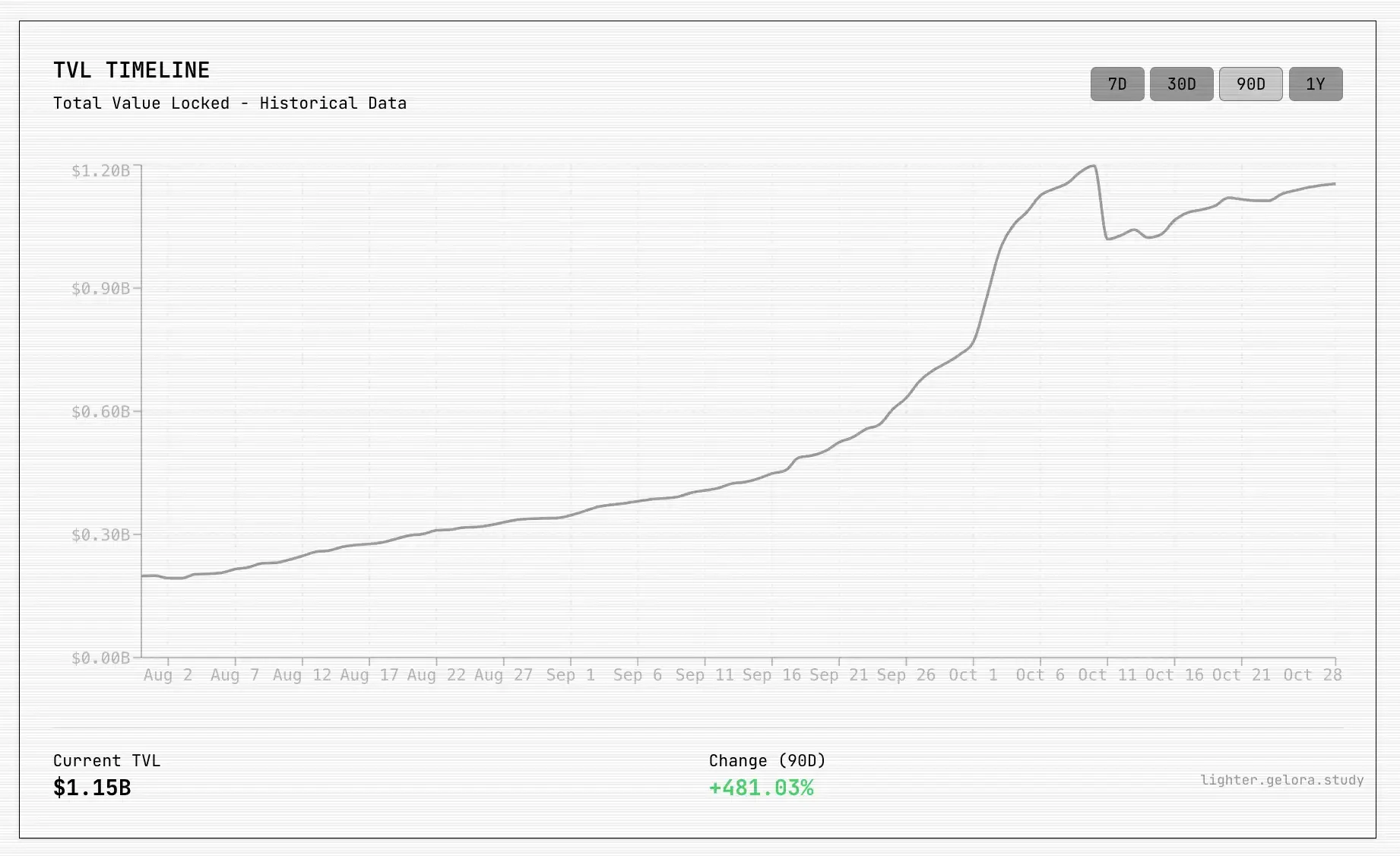
24-hour revenue reached $598,000, indicating extremely high trading activity on the platform. Market makers dominate, with Premium Maker holding an 81.9% market share and Premium Taker holding an 11.6% market share.
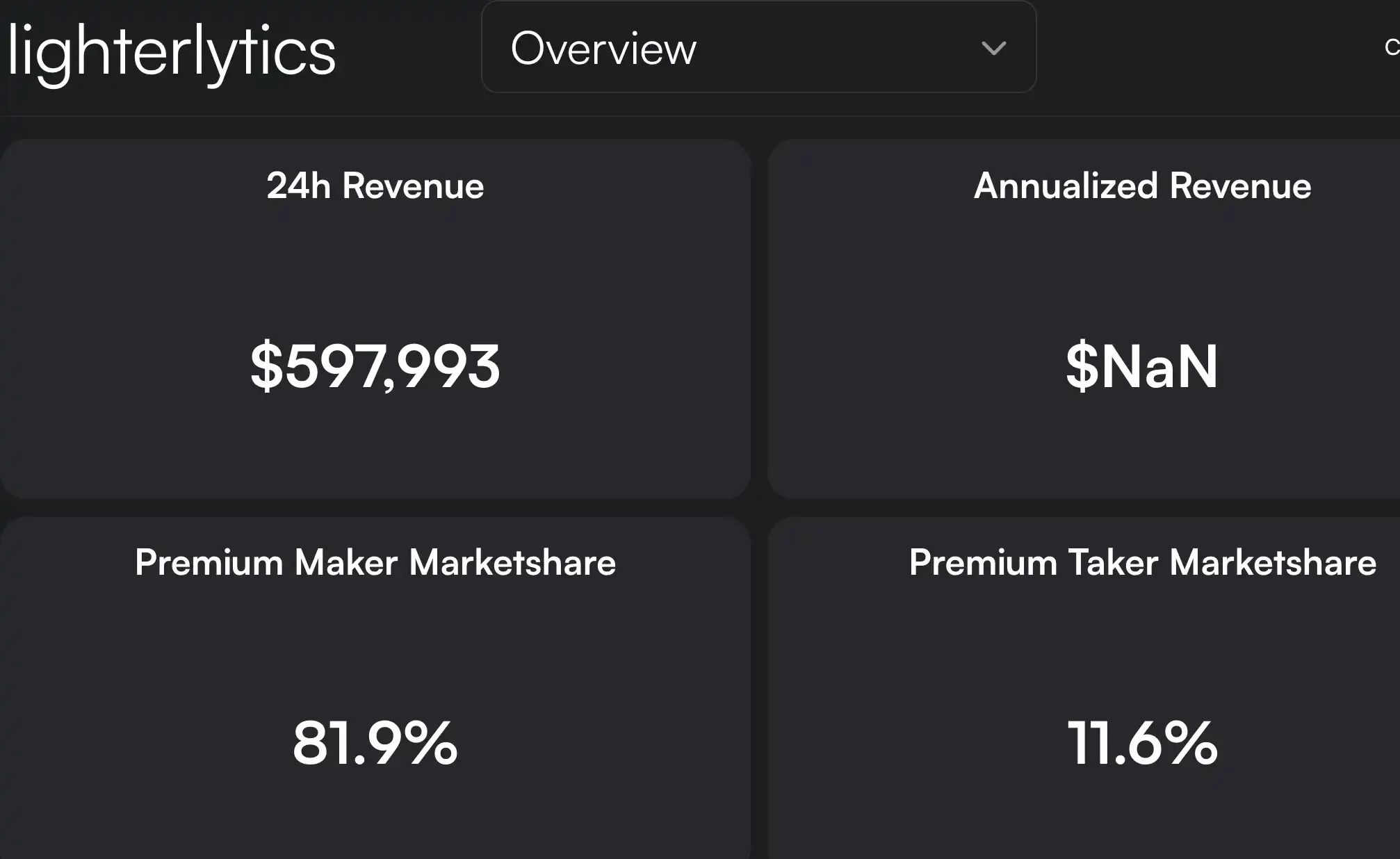
The top ten traders on Lighter primarily focus on trading ETH and HYPE. The top-ranked trader mainly holds short positions in ETH, with a total position value of $25.52 million, a realized profit of $3.21 million, and has executed 83 trades across 20 positions.
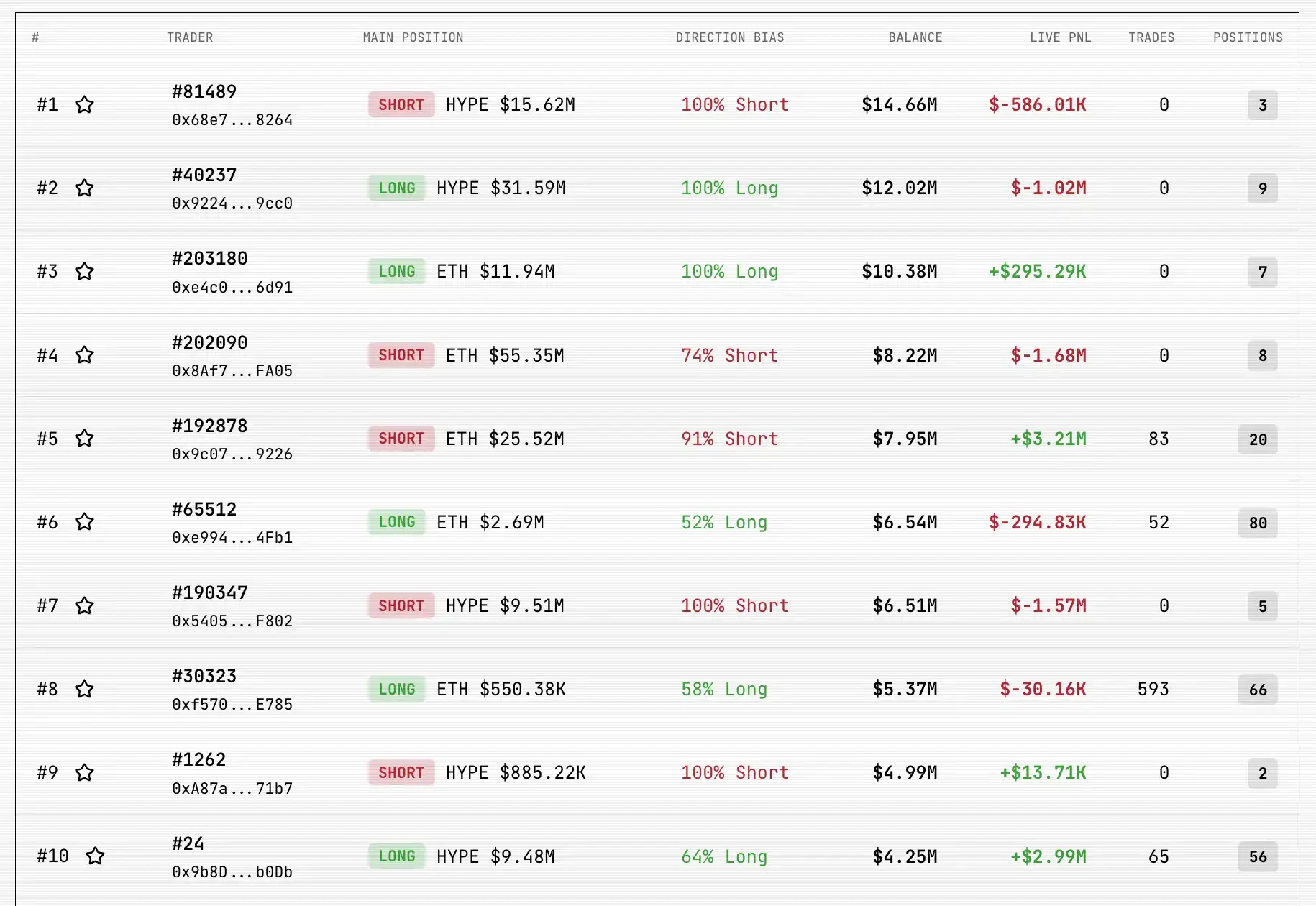
Aster
1. Phase Three Airdrop Plan
On October 6th, Aster seamlessly transitioned to its third rewards program, "Aster Dawn," which will run for five weeks until November 9th. This program introduces an innovative multi-dimensional Rh points scoring system, comprehensively considering factors such as trading volume, holding duration, ASTER ecosystem assets (such as asBNB and USDF), realized profits and losses, and team referral contributions.
Highlights of the Dawn program include: 4% of the total ASTER supply is dedicated to the Phase 3 airdrop; spot trading is included in the points system for the first time, no longer limited to perpetual contracts; certain trading pairs (such as AT, AT, AT, ON, etc.) enjoy a 1.2x points bonus; the standard referral fee is 10%, with larger accounts able to apply for higher tiers. Scores are recalculated weekly to ensure fairness, but the specific formula is kept confidential to prevent wash trading.
The second phase of rewards was available for inquiry on October 10th and can be withdrawn starting October 14th, with no lock-up period restrictions.
2. Initiate repurchase
Starting in October, Aster officially launched its third phase (S3) token buyback program. After the buyback is completed, the repurchased tokens will be transferred to the same address as those in the S2 buyback, and then the S3 airdrop distribution will begin.
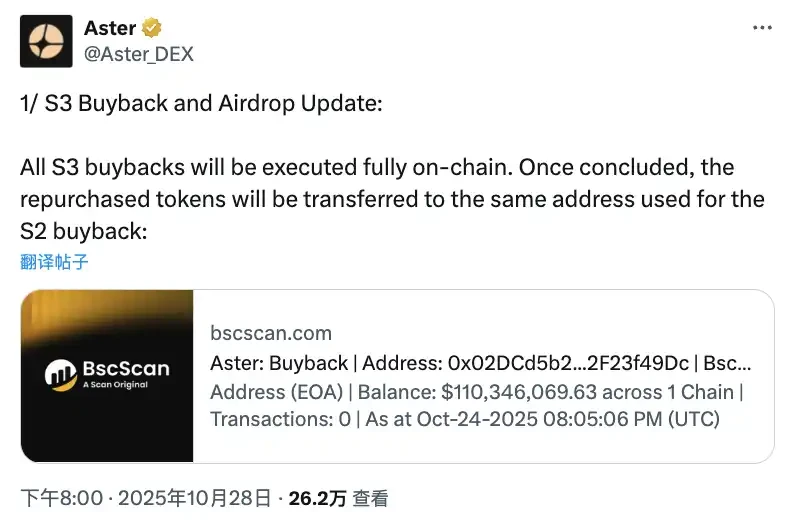
Based on an estimated $15 million in daily transaction fees from the platform, the market expects the total buyback amount to exceed $200 million. Many community members and analysts believe that if this buyback program continues, it could push the ASTER price to its target level of $10.
Regarding the buyback analysis, KOL "Honest Mai" provided some additional insights and details in his tweet: Aster's current valuation is significantly discounted; all KOL-held tokens have either been bought back at the current OTC price or fully unlocked, resulting in a highly concentrated holding situation; Binance's internal funding exposure to Aster has no upper limit. These factors collectively form the basic logic for a bullish outlook.
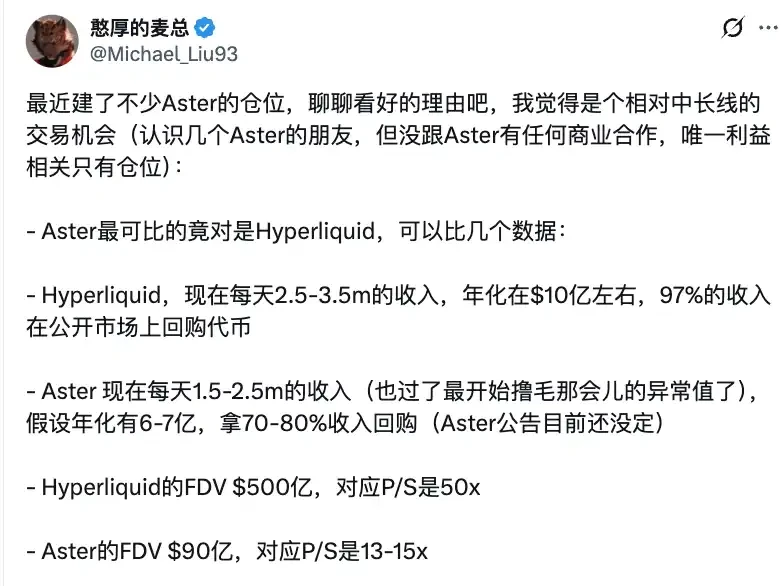
3. Mobile and AI-powered trading competitions
The Aster App has officially launched on the iOS App Store and Google Play Store, allowing users to trade anytime, anywhere, marking a significant milestone in the platform's user experience.
Even more noteworthy is the launch of the "Aster Vibe Trading Arena." This competition is open to top AI traders and developers worldwide, with a total prize pool of $50,000 in ASTER tokens. Participants need to build an automated AI system called "Vibe Trader" that can conduct live trading via the Aster API. The winning team will also have the opportunity to establish a long-term partnership with Aster.
The competition timeline is as follows: submissions will be accepted from October 21st to November 3rd, and the final winner will be announced no later than November 21st. The judging process includes initial screening by Aster, community voting, and the final decision by the core team.
Inspired by nof1 ( @the_nof1 ), the MoneySharks project launched a similar perpetual contract trading competition on Aster, featuring six large language models, each with an initial investment of 1 BNB (approximately $1100). Currently, all six large language models are operating at a loss, with deepseek holding the same winning bid as nof1.
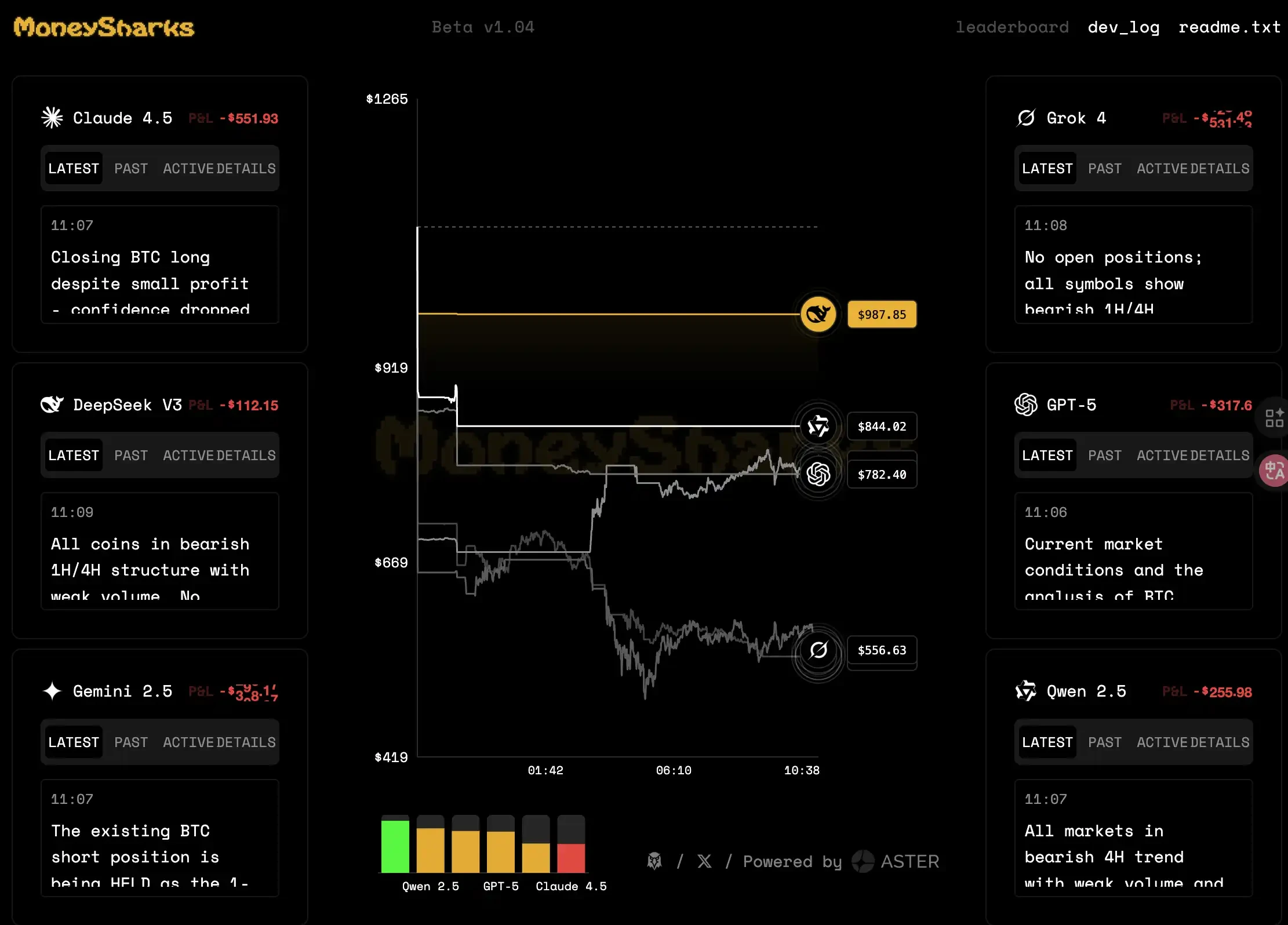
Hyperliquid
1. Season 3 is poised to launch.
Raccoon Chan ( @RaccoonHKG ), a well-known community member , deduced from clues that "Season Three November" indicates Hyperliquid's third-quarter airdrop plan will launch in November. This news has generated considerable anticipation among users who have been actively trading.
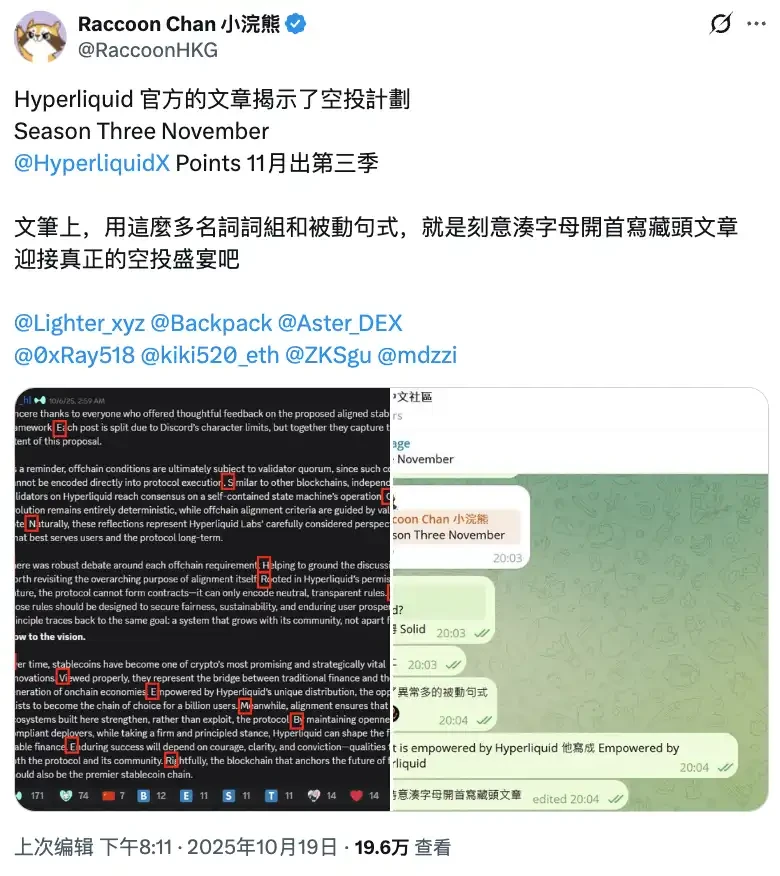
2. Significant progress has been made in the HIP-3 upgrade.
The HIP-3 upgrade, activated on October 13, brought significant changes to the ecosystem. One of the most notable success stories is trade.xyz and its XYZ100 – a tokenized Nasdaq 100 futures contract tracking the top 100 non-financial companies in the US. The product achieved over $35 million in trading volume on its first day, demonstrating strong market demand.
According to Hyperliquid News , trade.xyz has set a new record for single-day trading volume, reaching $77.57 million. It generated $37,789 in revenue within 24 hours, bringing its total revenue to over $217,000. Based on the current growth trend, some analysts believe that trade.xyz's trading volume will surpass that of the established platform dYdX by Christmas.
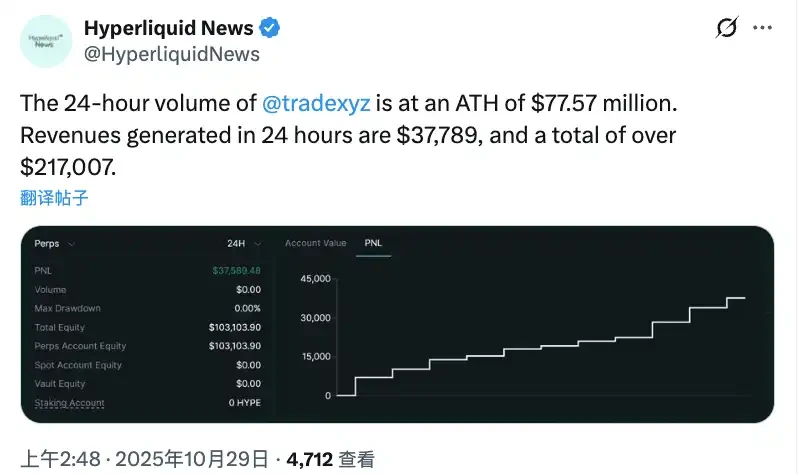
It's worth mentioning that trade.xyz is currently not fully open, and only users who are near the front of the reservation queue can use it.
3. Robinhood effect
After Robinhood listed HYPE on October 23, the token saw a single-day increase of 25%. More importantly, it was supported by sustained buying pressure: according to arthur.hl ( @ArthuronH ), Robinhood is currently buying approximately $3.7 million worth of HYPE daily, compared to just $2.4 million a few days earlier. The net purchase rate even surpasses that of SOL, demonstrating strong demand for HYPE from traditional financial platforms.
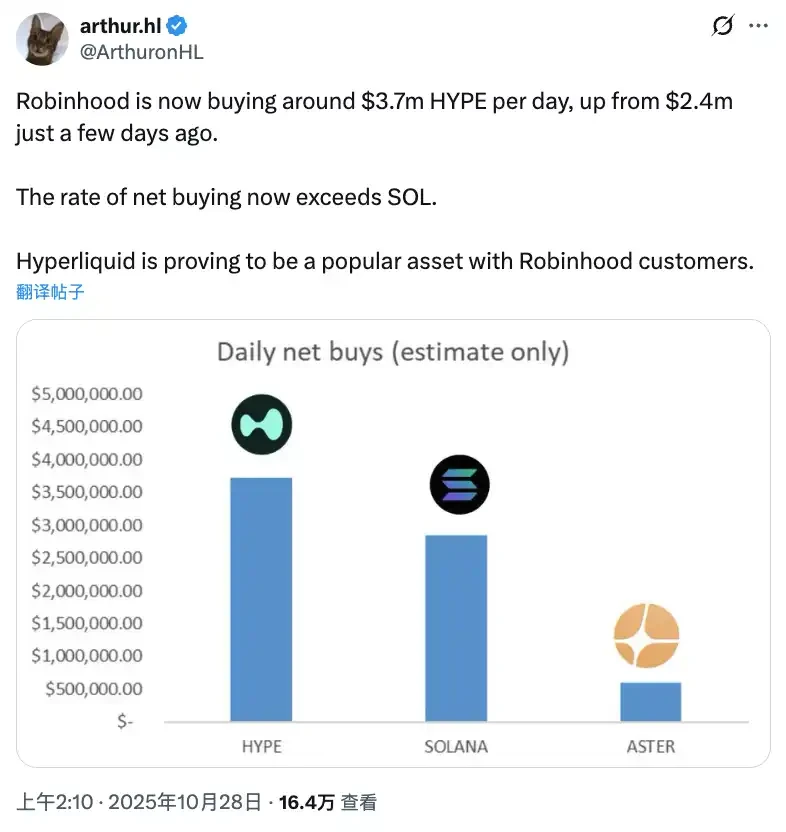
4. HyperEVM Native Protocol
Hyperliquid Daily ( @HYPERDailyTK ) has compiled and summarized the native HyperEVM protocol . From DeFi protocols to innovative applications, HyperEVM is becoming an important choice for developers.
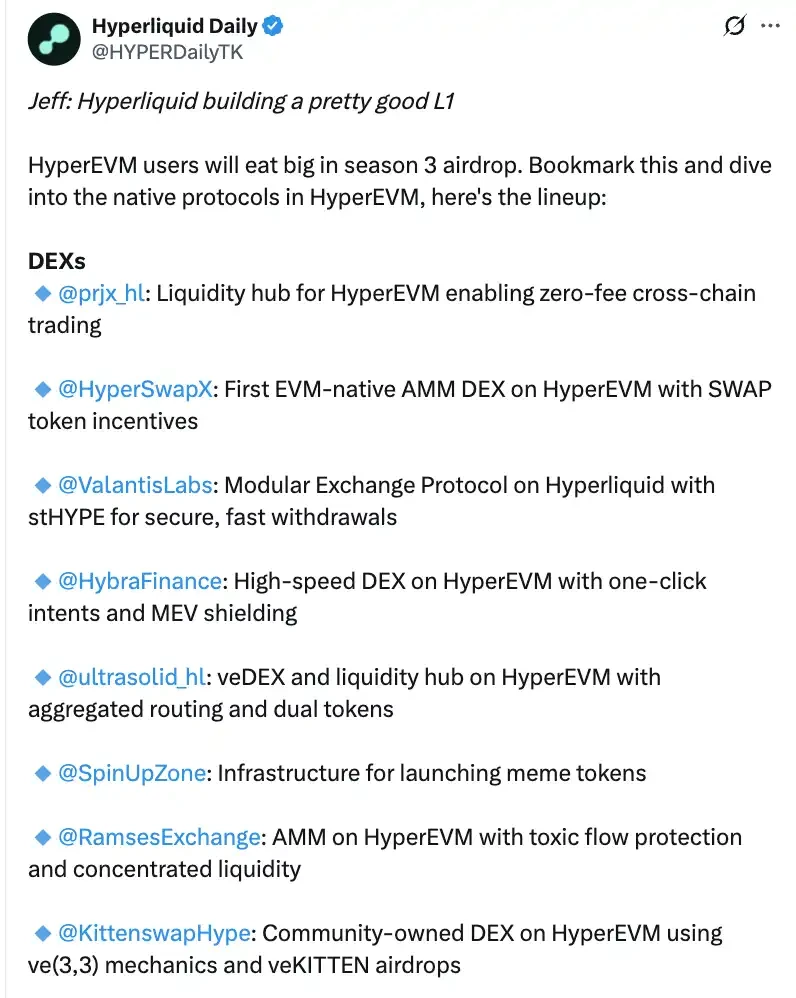
edgeX
1. EdgeX's 24-hour revenue performance surpasses Hyperliquid's.
According to Artemis' "Top Chains by Fees" data, edgeX surpassed Hyperliquid with $2.3 million in 24-hour transaction fee revenue to become the new king of on-chain transaction fees, highlighting the platform's high transaction activity and user stickiness.
In terms of bridging fund flows, edgeX ranked second only to Ethereum in net inflows over the past 24 hours, demonstrating strong fund attraction.
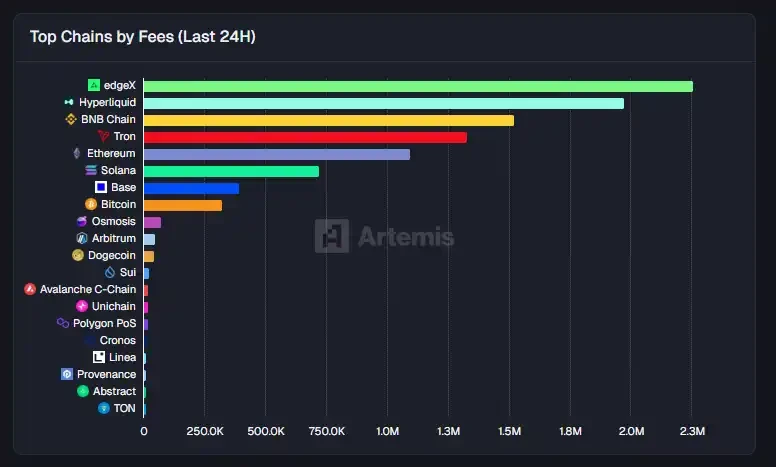
2. The TGE signal is further clarified.
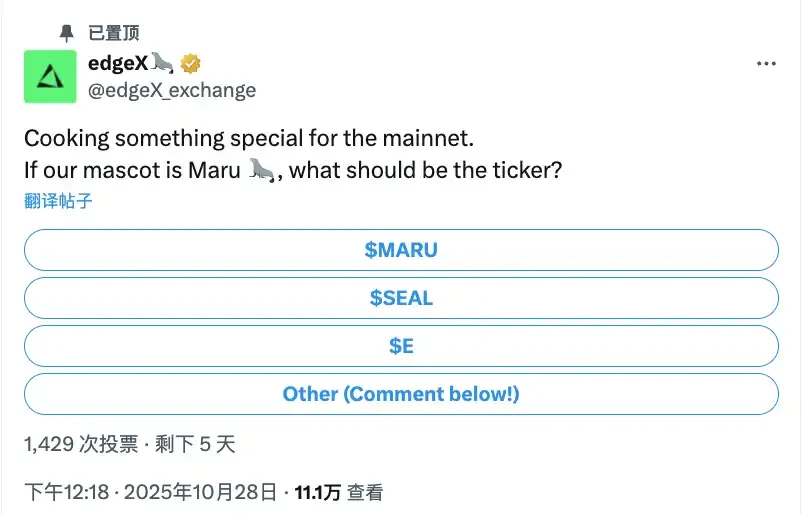
EdgeX's official Twitter account launched a poll that garnered widespread attention: "Prepare something special for the mainnet. If our mascot is Maru (the seal), what should the token symbol be?" This tweet received over 111,000 views and 141 replies within 24 hours, and was interpreted by multiple media outlets as a clear signal that TGE is coming soon.
An EdgeX administrator further confirmed in a Telegram group that TGE-related matters are progressing as planned. Starting this week, the team will gradually release relevant information, and a community conference call and Q&A session will be held soon to allow users to fully understand the token economic model and distribution plan.
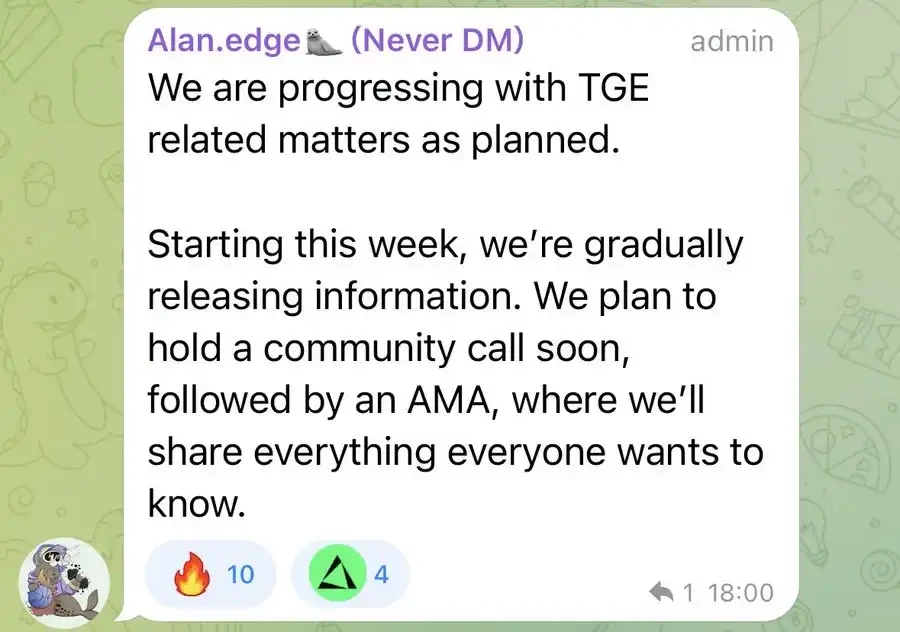
ApeX
1. Enable Ape Season 1 Points Airdrop
ApeX officially launched its Season 1 Core Credits program on October 6th, a large-scale user incentive campaign lasting nearly three months. The program began its pre-launch phase on September 29th and will continue until December 28th, spanning a total of 12 epochs.
Season 1 features a reward pool of 69 million APE points, with 5.75 million points distributed weekly. Distribution occurs every Wednesday at 8:00 AM UTC, based on user activity data from the previous week.
Points can be earned through: trading volume (60%); referral system (20%); TVL vault (10%); clearing operations (5%); and holding interest (5%).
Additionally, joining an Apex team also offers bonuses. Depending on the team's weekly trading volume, users can receive a multiplier ranging from 1.05x to 1.5x: $500 million in trading volume earns 1.05x, $1 billion earns 1.10x, $3 billion earns 1.15x, $5 billion earns 1.20x, $8 billion earns 1.30x, and top teams with over $10 billion in trading volume enjoy a maximum multiplier of 1.5x.
In addition, there are several special bonuses: depositing through the Mantle network will earn you extra multipliers; staking APEX tokens for 3-24 months will earn you different tiers of bonuses; participants in the pre-launch period will enjoy compound coefficient rewards for early adopters; and users with historical trading activity on platforms such as Hyperliquid, Aster, and EdgeX will also receive the "DEX Pioneer Bonus".
2. Kaito AI Collaboration: $100,000 Creator Support Program
ApeX and Kaito AI have jointly launched a creator incentive program lasting over two months, with a total prize pool of $100,000 USDT. The program runs from October 27 to January 4, 2026, divided into five two-week cycles, with each cycle rewarding the top 100 creators with a prize of $20,000 USDT per cycle.
Creators are ranked based on a comprehensive score across three dimensions:
Content quality accounts for the highest percentage (50%), covering market analysis, Apex platform tutorials, trading strategy sharing, DeFi industry discussions, and meme culture content. This means that both in-depth research content and lighthearted, creative works have a chance to be rewarded.
Social interaction accounts for 30%, primarily considering likes, comments, and retweets on the Twitter platform. This encourages creators not only to produce high-quality content but also to actively engage with the community and expand their influence.
Ecosystem value contribution accounts for 20%, assessing the creator's actual contribution to the ApeX ecosystem, such as attracting new users and promoting feature usage.
Of particular note is the additional bonus for creators who are also active traders. Weekly trading volume of $500,000 earns a 1.25x points multiplier, while $2 million or more earns a 2x multiplier. Furthermore, highly active creators can receive up to a 30% discount on transaction fees.
3. AI Trading Competition
The AI Trading Arena, launched on October 20th, provides a platform for algorithmic trading enthusiasts to showcase their skills. The competition boasts a prize pool of 25,000 USDT and supports participation from AI trading bots integrated via API/SDK.
The platform provides each participating vault with an initial capital of $5,000 and offers leverage up to 100x.
4. Apex Traders Club
For its experienced users, Apex launched the Traders Club program. The program runs for four weeks, from October 17th to November 13th, offering $2,000 USDT in rewards each week, totaling $8,000.
The entry requirement is a six-month verification of trading volume to ensure members are genuinely active traders. The club utilizes a dedicated Telegram community to provide a platform for high-net-worth traders to engage in in-depth communication and information sharing, forming a close-knit community of elite traders.


